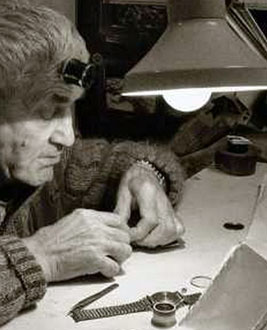Working Surface. Light.
Working Surface
The top of a bench does not present the best kind of a surface to work upon. It is much easier to see and work against a white background avoiding as much as possible any glare. Some Watchmakers use a piece of glass with white paper underneath but this is not always satisfactory as the hard surface of the glass is liable to damage certain parts of the watch if they are dropped upon it and there is more or less direct reflection of light, causing glare, unless it is ground glass. Others use a sheet of paper such as linen surfaced writing paper. This however, is soiled or torn easily and liable to rub into a sort of lint which has a tendency to stick to the watch parts.
I have found a much better working surface to be a flat piece of fairly heavy white celluloid with a matte or dull surface. It is not necessary that this cover a large portion of the bench. A piece 8 inches long and 5 inches wide is large enough and placed directly in front of you when seated at the bench and with the front edge flush with the back edge of the groove will be found most satisfactory. Test by trial the best location for you to work upon and then tack to the bench. Should the celluloid become soiled it can be cleaned easily with soap and water.
Do not lay any heated objects upon the celluloid and be careful not to get a flame too close.
Keep Your Bench In Order
A standard bench is provided with drawers in which to keep your tools and these should be placed and arranged so that you will know where each tool is and can reach it with the least effort. It is a good idea to have the drawers partitioned into various sized compartments.
In place of partitions you can use different sizes of pasteboard boxes. If boxes are used, see that you have enough to completely fill the drawer so That they cannot shift around, In the upper center drawers place your most used tools such as tweezers, screw drivers, bench keys, calipers, gauges, etc.
With the exception of tweezers, screw drivers, loupes or other tools which you are constantly using it is well to get in the habit of replacing each one in its proper place as soon as you are through with it. Not only does a profusion of tools scattered over the top of your bench make a bad impression upon your customers but it tends to slow you up as well. Train yourself to be systematic in all your work. Have a place for everything and then see that everything is in its place. When you leave your bench after a day’s work see that all the small tools are cleared away and then when you start work the next day, take out these tools only as you need them.
Proper Light

Whatever you use, bench or table, try to have it located near a well lighted window. It is better to have a good natural light, North preferred, than to depend upon any artificial light.
If you find it necessary to use artificial light-do not use it too strong. A 40 or 60 watt frosted light is strong enough and will not dazzle and tire the eyes as a stronger one will.
This should be so situated that the light will shine directly on the work but not into the eyes. Where electric current is available this can be arranged by means of an ordinary desk or bench lamp with shade.
Height of Seat
Nearly all beginners use too high a seat while working. With a stool or chair too bigh the body must assume a stooped position which proves tiresome within a comparatively short time.
The standard height of the watchmaker’s bench is 38 inches and for the average man an ordinary straight back chair with a seat seven-teen or eighteen inches from the floor proves very satisfactory when used with such a bench. At first this may seem a trifle low but after one gets used to it, he can work much longer without fatigue than with a higher one.
While working at the bench the apron should be drawn out until it touches the body and the elbows may rest upon the frame work of the apron slide. This allows the body to assume an easy position and brings the work in just about the right location to be examined and observed.
In the more advanced work when using the lathe, extra height should be added to the chair or stool to make it about 22 inches from the floor. This may he in the form of a pad five inches thick.
Many workmen at the bench use an ordinary four legged stool of a height best suited to their own individual needs.
| « Table or Bench. Watchmakers Auxiliary Home Bench. | Sizes of American Watches. Casing of Pocket Watches » |